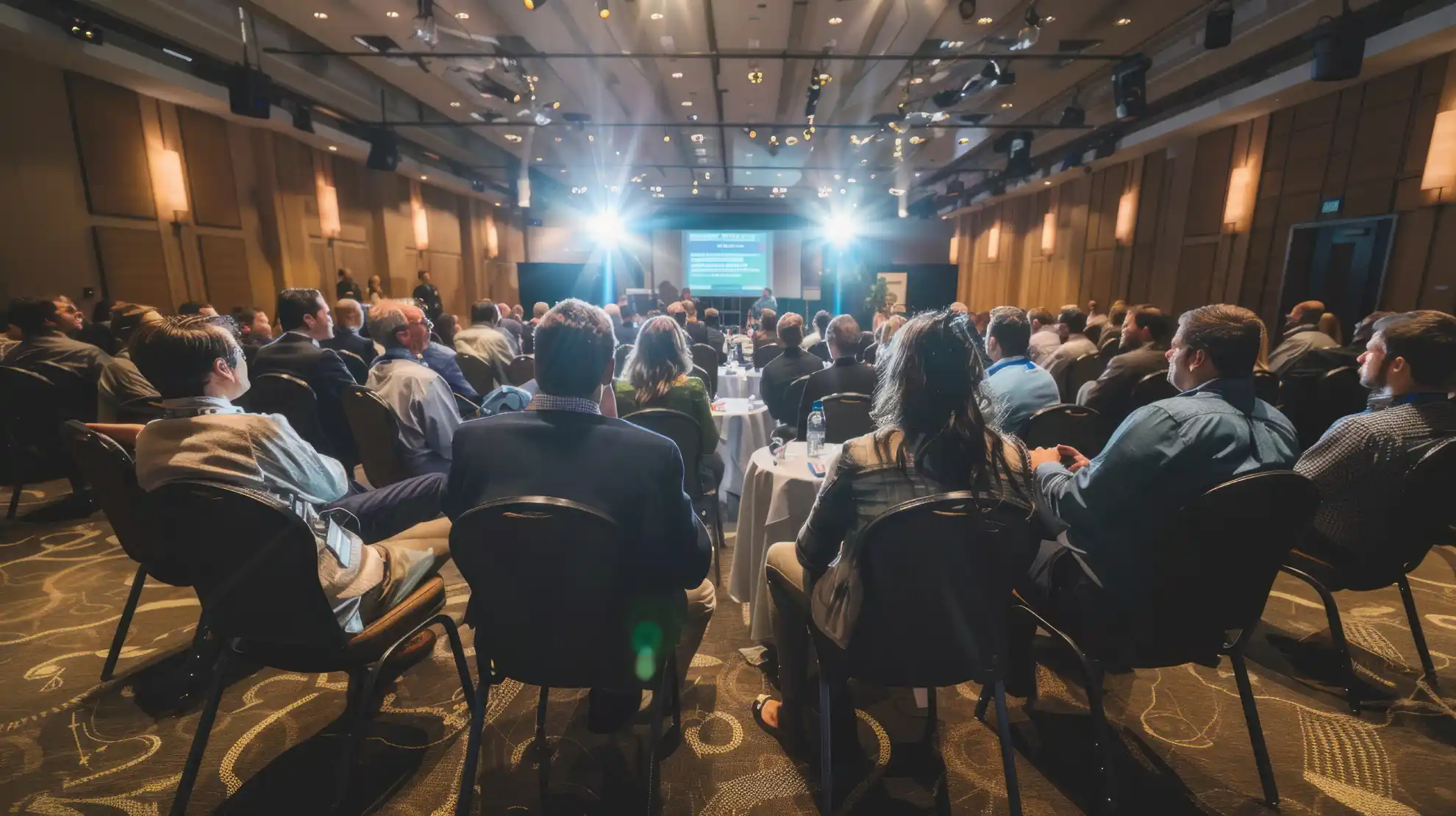Presenting at a conference is a crucial part of a professional’s journey, offering an opportunity to share months or even years of work with peers. It’s a chance to communicate your findings, engage in discussions, and potentially open doors to new collaborations. Conference ppts can also increase the visibility of your work, leading to more citations for academics and, for students, even awards that can boost their careers.
However, presenting at a conference can be nerve-wracking. It’s common to feel anxious, especially when you’re revealing your thought process and knowledge to an audience. But remember, even seasoned presenters experience nerves, and these feelings can be managed with practice.
To deliver a successful presentation in a conference, it’s important to avoid common pitfalls like overcrowded slide templates filled with bullet points and text. Instead, aim for clear, visually appealing slides that support your message rather than serve as a script. By focusing on engaging your audience and delivering your content clearly, you can make a lasting impression and contribute positively to your field.
Key Takeaways
- Outline Your Presentation: Outline your main ideas to keep your PowerPoint presentation focused and organized. This helps prevent overcrowded slide decks and ensures a logical flow of information.
- Use Visuals Wisely: Incorporate simple, relevant visuals to support your message. Ensure that your visuals are easy to comprehend, enhancing rather than distracting from your content.
- Know Your Audience: Tailor your presentation to match your audience’s knowledge and interests. This ensures that your content is engaging and appropriate for their level of expertise.
- Prepare for Q&A: Anticipate possible questions and practice concise responses. Use the Q&A session to clarify points and engage with your audience, demonstrating your expertise and readiness.
Types of Conference Presentations

Panel Presentations
Panel ppts are a common presentation format for conferences. In this setup, you’ll be one of three to four panelists discussing a theme or topic related to the conference. Each panelist typically has 15 to 20 minutes to present a paper at a conference, followed by a 10-minute question-and-answer session. This can happen right after your talk or after all the panelists have spoken.
Panels are designed to encourage discussion and interaction, not just with the audience but also among the panelists themselves. You can ask questions or respond to queries during the Q&A, creating a dynamic exchange of ideas. Sometimes, you may propose a panel with colleagues, which allows for more focused discussions, while other times, you might be placed on a panel by the conference organizers.
Whether you’re an expert in a specific issue, technology, or strategy, or representing an organization, panel presentations offer an opportunity to share your insights and engage in meaningful conversations with others in your field.
Roundtable Presentations
Roundtable presentations are a type of conference session where a small group of speakers, usually five to six, gather to discuss specific topics. Each speaker has about five to ten minutes to present their ideas or research. Sometimes, the speakers share their papers with the group or even with the audience before the session.
After the presentations, the focus shifts to an open discussion. The presenter leads the conversation, encouraging participants to share their thoughts, enquire, and explore the topic further. This format allows for more interaction and deeper engagement among attendees, making it an ideal setting for collaborative learning.
Workshop Presentations
Workshop presentations are hands-on sessions that focus on practical learning. Unlike traditional talks, workshops involve active participation from attendees. The organizer or presenter may start with a brief introduction, but the majority of the time is dedicated to engaging participants in activities. These activities often revolve around learning a specific technology, developing teaching materials, or experiencing a new technique firsthand.
The main goal of a workshop is to provide participants with a practical understanding of a concept or skill. Attendees not only learn by doing but also have the opportunity to ask questions about the effectiveness of the strategies or techniques being presented. This interactive format makes workshops valuable for those looking to gain practical knowledge they can apply immediately.
Poster Presentations
Poster presentations are a popular format at conferences where participants visually display their research or ideas on a poster. These posters, often made up of one or more A1-sized displays, include diagrams, text, references, and visuals. They are typically set up in a designated area alongside other posters.
A key aspect of poster presentations is that the poster should be understandable on its own, as attendees might view it outside the scheduled session. During the poster session, authors are present to discuss their work and answer questions. This interactive format allows for deeper engagement with viewers, making poster presentations a unique way to share research at academic conferences.
Tips for Presenting at a Conference

Begin with an Outline
Starting with an outline is essential when preparing for a conference ppt. It’s easy to get lost in your slides if you jump straight into creating them without a clear plan. Before you start building your slides, take time to outline your key ideas and the order in which you want to present them. This approach will keep your presentation focused and prevent you from adding too many slides or losing track of your main message.
Begin by listing your main points or creating a flowchart to visualize the sequence of your ideas. You can use sticky notes, paper, or online tools to help organize your thoughts. The goal is to structure your information logically, ensuring that each idea flows smoothly into the next. This will help you establish a clear and consistent message, making it easier for your listeners to follow.
Once your outline is set, use it as a roadmap to guide the creation of your slides. This method not only keeps your presentation organized but also ensures that you stay on topic and within the time limit. By starting with an outline, you’ll create a more effective and engaging conference style presentation.
Stick to the Timeline
Sticking to your timeline is essential when delivering a conference ppt. Conference organizers give you a specific amount of time, so it’s crucial to plan your presentation around that limit. If you have 15 minutes, prepare a presentation that lasts slightly less. This ensures you won’t rush or skip important slides, which can come across as unprofessional.
To stay on track, rehearse your presentation with a timer. This will help you gauge your pacing and make any necessary adjustments. Focus on the key points you want your audience to remember, and cut out any details that aren’t essential. If you’re running short on time during the presentation, it’s better to skip a few slides and make your final point, rather than rushing through everything.
Good time management not only helps you deliver a clear and impactful message but also leaves a positive impression on your audience.
Use Visuals Effectively
Using visuals in your conference PowerPoint presentation is essential for making your message clear and engaging. Whether you’re incorporating images, charts, or videos, these elements can help convey complex ideas more effectively than words alone. Visuals can help the audience understand the information you’re presenting, especially when dealing with data-heavy content.
However, it’s important to keep your visuals simple and focused. Overcomplicating them can confuse your audience rather than clarify your message. Choose visuals that directly relate to the points you’re making and avoid unnecessary details. For example, when presenting a paper at an academic conference, select the right type of chart—such as bar graphs, pie charts, or line charts—that best supports your message. Make sure your visuals are easy to read by using clear labels, appropriate colors, and consistent scales.
While presenting, use pointers or visual cues to highlight key points on your slides. This helps guide your audience’s attention and reinforces your message. Remember, the objective of using visuals is to aid understanding, not to overwhelm or distract your audience. Keep it simple, clear, and directly relevant to your message.
Know Your Audience
Understanding your audience is important to delivering a successful conference ppt. Different attendees come with varying levels of knowledge, interests, and expectations. Customizing your content to match their needs can make your presentation more engaging and impactful.
Start by researching who will be in the room. Are they graduate students, professionals, or a mix? Knowing their backgrounds will help you decide how much context to provide and whether to simplify complex ideas or dive into more advanced details. Reviewing past conference materials, such as participant lists, abstracts, or recorded talks, can offer valuable insights into the type of audience you can expect.
It’s important to avoid assuming that your audience knows either too much or too little about your topic. If they’re attending your session, they likely have a basic understanding of your field, so avoid spending too much time on background information. Instead, focus on what’s new and relevant to them. A good rule of thumb is to move on to your key findings or case studies within the first few minutes of your talk.
Additionally, use language that connects with your audience. Avoid heavy jargon unless you’re sure everyone will understand it. If you’re unsure about their familiarity with certain terms or concepts, don’t hesitate to ask questions during your presentation. This not only clarifies understanding but also engages your audience, making your presentation more interactive.
Knowing your audience and adapting your content to their level of expertise will help you deliver a presentation that is both engaging and memorable.
Practice
Effective practice is key to delivering a smooth and confident conference presentation. To ensure you know your material inside and out, rehearse your speech aloud. Familiarize yourself with every slide and make sure your key points and transitions are clear. This helps prevent getting lost or stumbling during your presentation.
Practicing in front of a mirror or recording yourself can be very helpful. Watching the recording lets you spot issues like speaking too quickly or missing pauses. This feedback allows you to make necessary adjustments.
Additionally, practice in front of colleagues to simulate a real presentation setting. Their reactions can reveal if certain parts are unclear. Have them note their feedback without interrupting, and use a timer to stay on track.
Presenting to someone unfamiliar with the topic can also be beneficial. If they can follow along, it’s likely your audience will too. Rehearsing multiple times and seeking honest feedback will build your confidence and fluency.
Remember, the more you practice, the more comfortable and assured you will feel on the day of your presentation.
Dress for the Occasion
When preparing for a conference ppt, your appearance plays a significant role. While your audience is primarily interested in your content, how you present yourself also matters. Opt for clothing that is both comfortable and appropriate for the event.
Choose attire that makes you feel at ease while speaking to your audience. If you are unsure about what to wear, check the dress code with the event organizers or consult with colleagues.
Keep in mind that conference rooms can become warm, so select clothing that won’t show perspiration if you tend to sweat when nervous. Avoid outfits that are too tight or uncomfortable, even if they seem to project confidence. Feeling comfortable in what you wear will help you look and feel more self-assured.
Backup
When it comes to conference presentations, always prepare for the unexpected. Technology can fail at the worst possible moments, so having a backup plan is crucial. Start by saving your presentation in multiple locations—store a copy on a hard drive, upload another to the cloud, and email it to yourself for easy access. You might also consider printing a paper copy, especially if you’re presenting a poster, although this can be more challenging.
Additionally, it’s a good idea to send a copy of your ppt to the event organizer or a trusted colleague. This ensures someone else has access if something goes wrong.
If your presentation includes videos, double-check that the venue’s technology can handle both the visual and audio aspects. Not all conference facilities are equipped with the latest or most compatible tech, so communicate your needs to the organizers well in advance.
Remember, it’s better to be over-prepared than to find yourself stranded in the middle of your presentation. Take no chances—back up everything.
Leverage Your Body Language

Body language plays a vital role in delivering an engaging conference ppt. When used effectively, it can help emphasize your key points and keep your audience interested. Begin by maintaining good eye contact with your audience, as it makes them feel that you’re speaking to them personally. However, be sure to spread your gaze around the room rather than focusing on just one person.
Your posture also matters. Stand tall, relax your shoulders, and avoid slouching. A straight, open posture shows confidence and helps you project your voice clearly. If you have notes, keep them at eye level or memorize your content to avoid looking down too often.
Gestures are another powerful tool. Use your hands to highlight important points or direct attention to your visual aids. Just be careful not to overdo it or engage in distracting habits like fidgeting, repeatedly fixing your clothes, or playing with objects. By moving purposefully and using your body language thoughtfully, you can create a more compelling presentation.
Use Impactful Design
Creating a visually appealing and effective conference presentation involves thoughtful design choices. Start with an opening slide that grabs your audience’s attention. Use an engaging visual, a thought-provoking quote, or a question that piques curiosity. This sets the tone for the rest of your presentation.
Stick to basic design principles throughout your slides. Avoid distracting colors, and limit yourself to no more than two colors per slide. If you use a light background, opt for a dark font, and vice versa. Ensure your font size is large enough for everyone to read comfortably, and avoid overloading slides with too much information. Aim for about five bullet points per slide, using them to highlight key points rather than overcrowding the screen.
Visuals should be clear and large enough to be seen from the back of the room. Consider using some images as backgrounds, but be cautious with text placement to maintain readability. If the text is hard to read, add a color layer with reduced opacity over the image.
Apply the principle of negative space to your slides. This “less is more” approach helps your design breathe, making it easier for the audience to follow the content. Finally, end with a compelling closing slide that drives your main message home and leaves a lasting impression.
Prepare for a Q&A
A successful conference ppt goes beyond just sharing your research; it also involves engaging with your audience through a Q&A session. This is your chance to address any lingering questions and provide clarity on points that might have been rushed or missed. To make the most of this opportunity, it’s important to prepare in advance.
First, anticipate questions that may arise. Since you can’t cover every detail in your presentation, think about what topics might spark curiosity or need further explanation. Preparing answers for these questions will help you feel more confident and in control during the session.
Time management is key. Aim to leave enough time at the end of your presentation for at least 1-3 questions. Avoid lengthy responses; instead, give concise answers and offer your contact information for further discussion. This keeps the session moving and ensures more questions can be addressed.
It’s okay if you don’t know the answer to a question. Be honest, and let the audience know you’ll look into it and get back to them. This shows professionalism and a commitment to thoroughness.
If you’re nervous about tough questions, consider having a trusted colleague ask a pre-arranged question to get the conversation started. This can ease you into the Q&A and boost your confidence.
Finally, keep a notebook handy to jot down interesting or challenging questions. Reflecting on these later can help improve your future presentations. By preparing thoughtfully, you can turn the Q&A session into a valuable part of your presentation experience.
Wrap-up: Tips for Presenting at a Conference
Presenting at a conference offers a significant opportunity to showcase your work, engage with peers, and potentially open new avenues for collaboration. To make your presentation effective, start by outlining your main ideas and sticking to a clear timeline. Use visuals wisely to enhance understanding rather than overwhelm your audience. Tailoring your content to your audience’s level of expertise ensures relevance and engagement. Practice thoroughly to build confidence and handle any presentation hiccups with ease.
Remember to dress for the occasion and prepare for potential technical issues by having backups ready. During your presentation, leverage body language to maintain engagement and make a strong impression. Finally, prepare for a Q&A session to address any questions and provide clarity on your work. By following these tips, you’ll deliver a memorable and impactful conference presentation.
Frequently Asked Questions (FAQs)
1. What are the common types of conference presentations?
The main types are panel, roundtable, workshop, and poster presentations. Panels involve multiple speakers discussing a theme, roundtables focus on open discussions among a small group, workshops offer hands-on learning, and posters showcase research visually.
2. How can I manage my presentation time effectively?
Stick to your allotted time by rehearsing with a timer. Aim to finish slightly early to avoid rushing. Focus on key points and cut unnecessary details to stay within your time limit.
3. What role do visuals play in a conference presentation?
Visuals help clarify and emphasize your message. Use simple, relevant images, charts, and graphs to support your points, and ensure they are easy to read and understand.
4. How should I prepare for a Q&A session?
Anticipate potential questions and prepare concise answers. Leave time for at least 1-3 questions, and handle any tough questions honestly, offering to follow up if needed.
Master Your Conference Presentation with Prezentium
Preparing for a conference presentation can be daunting, but with Prezentium, you can transform it into a smooth and impactful experience. Whether you need an overnight presentation crafted from scratch or assistance in fine-tuning your existing slides, our AI-powered service ensures you have a polished and professional presentation ready by the next morning.
Our Accelerators service helps refine your ideas and notes into stunning visuals and engaging designs, while Zenith Learning offers interactive workshops to hone your communication skills. We focus on clear, effective design and practical strategies to make your message resonate with your audience.
Don’t let presentation jitters hold you back. Partner with Prezentium to deliver a confident and memorable performance. Get in touch today to see how we can help you shine at your next conference!
